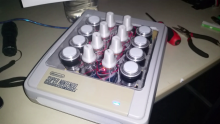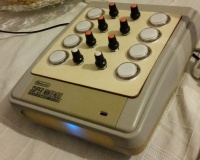Archive:SNES DJ Controller: Difference between revisions
No edit summary |
|||
| Line 1: | Line 1: | ||
{{outdated|type=member project|moretext=Project from 2017}} | |||
{{project | {{project | ||
|name = SNES DJ Controller | |name = SNES DJ Controller | ||
Revision as of 13:04, 10 September 2022
 You are visiting an old member project. The information found on "SNES DJ Controller" might be out of date. Project from 2017
You are visiting an old member project. The information found on "SNES DJ Controller" might be out of date. Project from 2017| SNES DJ Controller Release status: beta [box doku] | |
|---|---|

| |
| Description | A small MIDI-Controller for DJs inside a casing of a SNES |
| Author(s) | Jan |
Overview
Parts used
- 50 RGB LEDs, common anode
- USB<->MIDI Cable
- 8 Arcade Switches white/clear
- 8 potentiometers 10k, mono, linear, no raster
- TLC5940 LED driver
- SNES
- Arduino Mega
- Plexiglas
Most of the stuff was already there. I just had to order the bold marked things.
Milestones
☑ sending MIDI
My first goal was sending MIDI data to the PC. MIDI is a pretty basic serial protocol transmitting data with 31250 baud. For testing purposes i send data at 9600 baud via the arduinos serial interface to a software called Hairless MIDI. This will be changed in the future.
☑ preparing the case
All of the inner parts of the Super Nintendo have been removed. This includes the controller ports, the main PCB, the top dark-grey panel and also some plastic struts. The Controller-Port in the front was replaced by a 3d printed part. You can get the .stl and openscad file here: snes_front.zip The (still working) console parts will be put into a new fancy case to give this classic console a new life.
☑ cutting the faceplate
The faceplate was laser-cut. Until now i have built three iterations of this part.
- Wood - Buttons were too close together and had only 24mm holes.
- Wood - Buttons and pots fit great
- Plexiglas (latest) - same as above but shiny, see-through acrylic glas
i knew it was a great idea to order that casemodding window kit back in 2003.
You can get the latest files here: snes_faceplate.zip (contains SVG and DXF)
☑ installing and wiring buttons and pots
☑ make nice holders for the components
☑ add blinkenlights
Every project needs blinkenlights.
Although the arduino has 54 digital outputs it cannot provide enough energy for 16 RGB LEDs (48 channels). Therefore i used the awesome TLC5940 LED driver ICs for driving the LEDs. For this i soldered a own breadboard
Demo-video here: [1]

